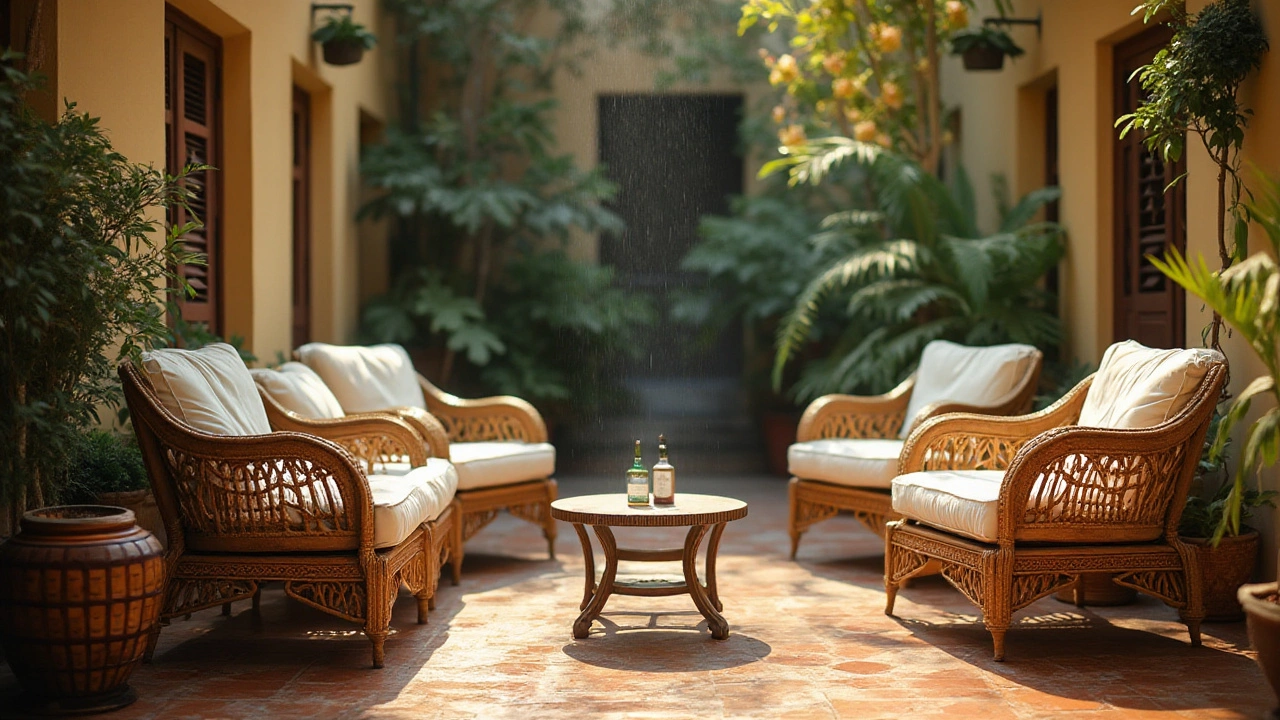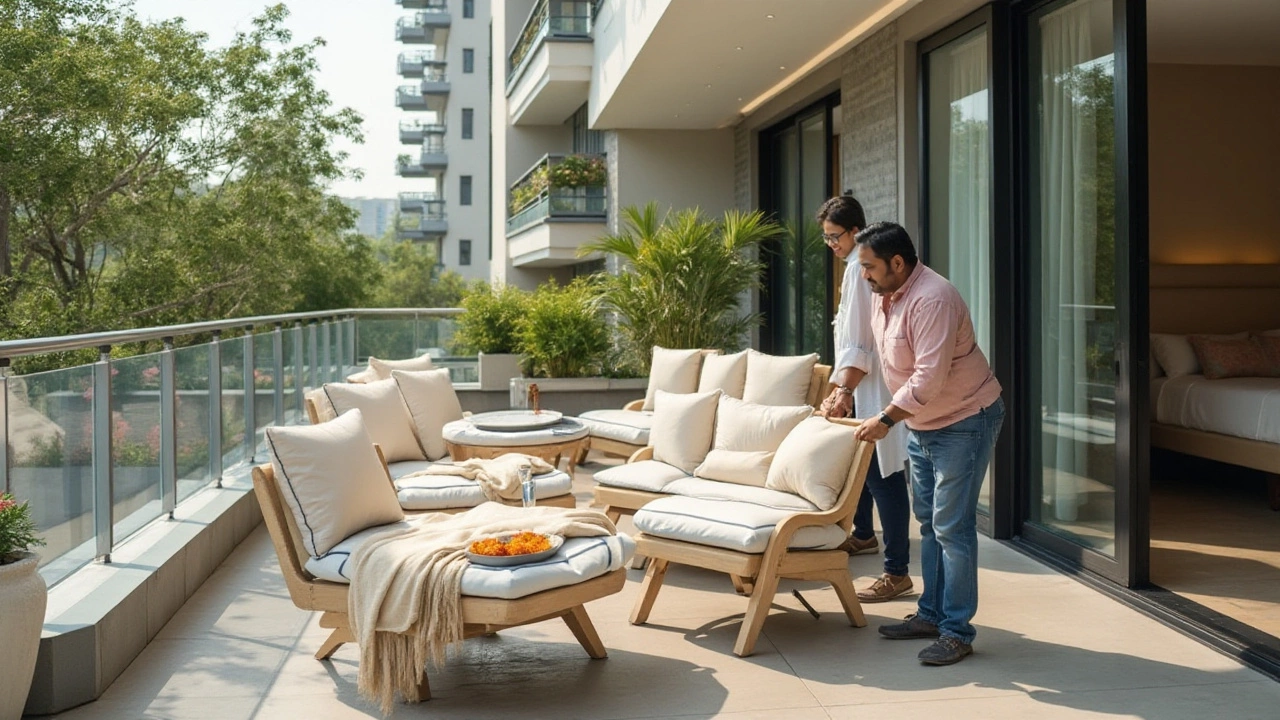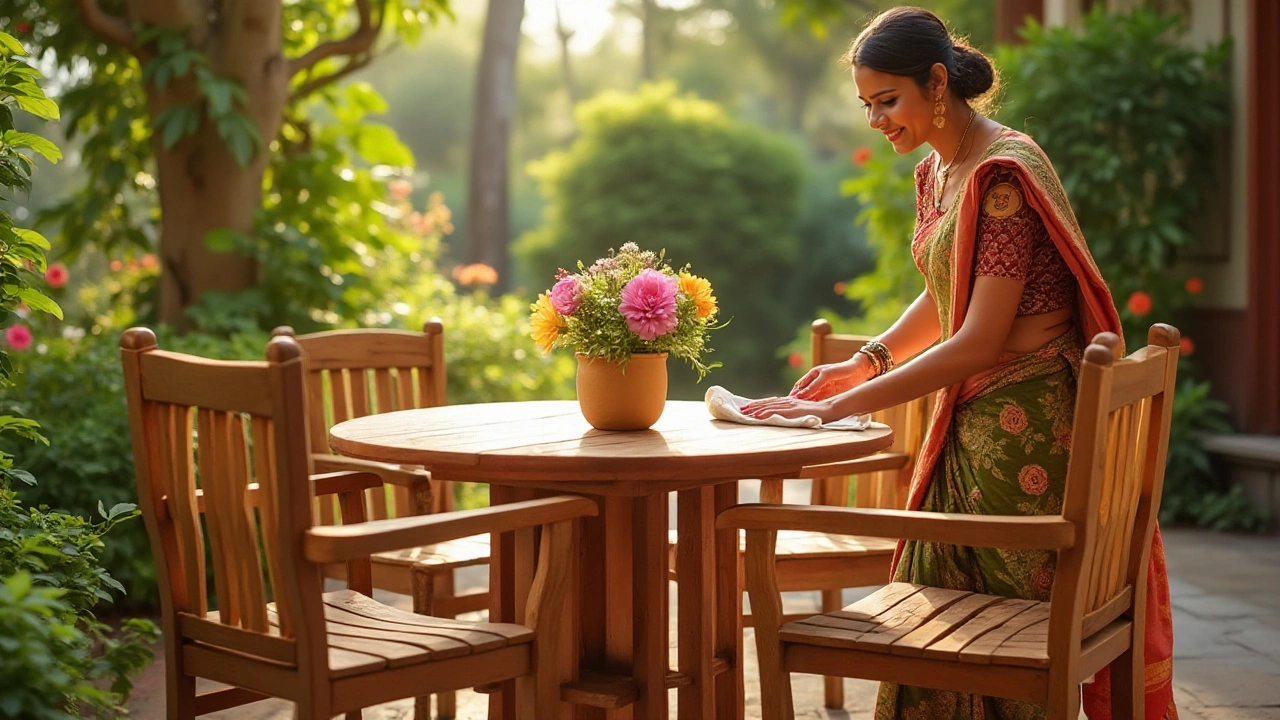Outdoor furniture can transform any garden into an inviting retreat, offering a space to relax and enjoy the natural surroundings. But as welcoming as these pieces are, they often fall prey to the pesky problem of mold and mildew. With their unsightly appearance and potential to damage materials, finding a way to keep these organisms at bay is essential.
Luckily, nature isn't without its solutions. By understanding why mold and mildew love garden furniture, and taking a few practical steps, you can keep your outdoor area looking fresh. Whether it's wooden benches or metal chairs, each material needs a unique approach. Simple cleaning routines and the right protective measures can go a long way in preventing these unwelcome guests. So, let's explore ways to protect your investment so you can enjoy the great outdoors worry-free.
- Understanding Mold and Mildew Growth
- Cleaning Methods for Different Materials
- Protective Coatings and Sealants
- Regular Maintenance Routines
- Seasonal Storage Tips
- Choosing Mold-Resistant Furniture
Understanding Mold and Mildew Growth
Mold and mildew are more than just eyesores on your beloved outdoor furniture; they are living organisms that thrive in specific conditions. Generally, they favor damp, dark, and warm environments where they can flourish at an alarming rate. Though they share some similarities, they aren't identical. Mold is typically black or green, while mildew appears in gray or white powdery patches. Knowing their distinctions aids in effective treatment and prevention.
Humidity is a significant contributor to the spread of mold and mildew. Both thrive where moisture is present, meaning areas of the country with high humidity levels often see more severe infestations. This is why your garden furniture, often left in the open and exposed to various weather conditions, becomes a prime target. Mildew and mold release spores into the air, which latch onto wet surfaces, thereby perpetuating their growth cycle. If you live in a region where it rains frequently or near a body of water, you're undoubtedly familiar with wiping them off more than you'd prefer.
Poor air circulation poses another challenge for keeping your furniture mold-free. Outdoor spaces—even large ones—where airflow is restricted, often experience mold and mildew growth more aggressively. This may include patios surrounded by dense landscaping or decks partially shaded by trees. Finding a balance between shade for comfort and air circulation is crucial. To combat this, try arranging your garden maintenance routines to allow for natural breezes to pass through your outdoor areas.
Materials also play a vital role. For instance, mold favors surfaces that can retain moisture, such as untreated wood, fabric, and wicker. Metals and plastics might not be immune either, as these materials could develop crevices where dampness lingers. Ensuring your items have protective coatings, whether it's a sealant on wood or water-resistant finishes on fabric, can be an essential step in prevention. It's worth noting that products designed to treat surfaces with these in mind have made significant strides over the years.
"An understanding of mold and its environmental needs is pivotal in implementing successful preventative measures," says Dr. Janet Thompson, an environmental scientist renowned for her studies on mold adaptation.
Natural occurrences aren't the only cause of mold and mildew. Poor storage choices or packing away furniture without cleaning and drying it first can secretly cultivate these unwanted guests. Routine cleaning of your furniture before storage, especially for the winter months, ensures no surprise outbreaks come spring. Active monitoring, along with proper cleaning, holds key responsibility for a long-lasting outdoor set.
On occasions where mold has claimed its hold, understand that it's not the end of your furniture's life. Many products on the market are capable of treating and halting its progress. Made from both chemical substances as well as natural ingredients, these solutions vary in effectiveness depending on mold type and surface material. Of course, consistency in their application and reapplication, based on manufacturer recommendations, is critical to their success in maintaining your outdoor area mold-free. Monitoring and reapplication make it possible to extend their effectiveness and keep your beloved pieces safe.
Cleaning Methods for Different Materials
When it comes to maintaining the charm of your outdoor furniture, understanding the proper cleaning methods for each material is paramount. Every piece, whether it’s made from wood, metal, or fabric, demands a tailored approach to keep mold prevention strategies effective. Wooden furniture, for example, often showcases natural beauty and durability. Yet, it can absorb moisture if not properly sealed, leading to mold and mildew. To clean wooden pieces, mix a solution of mild detergent and warm water. Apply this gentle mix with a soft brush, scrubbing in the direction of the grain. Rinse with a garden hose, ensuring all soap residues are removed, as they can attract dirt if left behind. Regular application of protective sealants further protects against moisture intrusion.
Metal Furniture: Rust and Mold Prevention
Metal furniture, with its sleek design and sturdy frame, can also be susceptible to the elements. While it doesn't absorb water like wood, standing water and humidity can lead to rust and mold. A simple cleaning solution of vinegar and water can work wonders here. Spray your metal chairs and tables with this solution, let it sit for a few minutes, and then wipe clean with a dry cloth. A coating of wax after cleaning can provide an extra layer of protection against moisture. Galvanized steel and powder-coated metals resist corrosion better but should still be checked regularly for any signs of damage where mold might shelter.Fabric and Cushions: Deep Cleaning Tips
The soft, cozy cushions that often adorn garden seats are magnets for mold if neglected. Most outdoor fabrics are water-resistant but not entirely waterproof, allowing mold to settle deep within. To tackle this, remove covers and wash them in a solution of warm water and white vinegar. For cushions that can't be removed, using a fabric cleaner with a soft-bristle brush can help lift mold spores. It's critical to dry these items thoroughly under the sun, as damp spots are mold's favorite breeding grounds. Where possible, store these cushions indoors during off-seasons."The key to prolonging your outdoor furniture’s lifespan lies in regular, seasonal cleaning," advises Kyle Watson, a noted landscape architect. “Consider it a rhythm of the seasons, much like caring for a garden itself."
In regions with high humidity or frequent rainfall, vigilance is particularly important. If you're looking for faster results, specialized commercial cleaning products are available, designed to target and eliminate mold spores effectively. However, always test these products on a small area first to ensure they don’t discolor your furniture. With these practical and customized cleaning approaches, any nature enthusiast can enjoy their garden space free from mold and mildew, all while keeping their beloved furniture in stellar shape.

Protective Coatings and Sealants
When it comes to preserving outdoor furniture against the relentless attack of mold and mildew, the application of protective coatings and sealants becomes an indispensable strategy. These mighty barriers form a resilient shield between your beloved pieces and the harsh elements. For materials such as wood and metal, there's no better defense than a trusty sealant. These products often come infused with ingredients that actively repel moisture, which is known to be the primary culprit in fostering mold growth.
For wooden furniture, consider using a quality varnish or a water-repellent stain. These not only enhance the natural beauty of wood but also penetrate the grain, sealing it against moisture. On the flip side, metal furniture benefits greatly from rust-inhibiting primers followed by a layer of polyurethane paint, which provides a robust waterproof layer. A well-sealed piece means less chance for water to infiltrate and stand long enough to serve as a breeding ground for mold and mildew.
The secret lies in the regularity of application. A mold prevention routine, implemented annually, ensures your furniture remains untarnished throughout the changing seasons. An interesting fact from the gardening guru Peter Abernathy suggests, "By establishing a twice-yearly regimen of stripping and resealing, you can prolong the life of your wooden outdoor furniture by up to 15 years." This periodic upkeep not only helps maintain the furniture's appearance but also fortifies it against the cyclical onslaught of the elements.
If you're inclined towards environmentally-friendly alternatives, many eco-friendly sealants are available that provide similar protection without the chemical baggage. These options, which often use plant-based oils or waxes, are gaining popularity and are worth the investment. Applying these may require more frequency, but they leave your conscience clean along with your garden.
To encapsulate this, here's a quick checklist: First, clean your furniture thoroughly to remove existing mold, paying special attention to grooves and crevices. Next, select the appropriate type of sealant, paying attention to the specific material of your furniture. Then, apply the sealant following the manufacturer’s instructions, ensuring complete and even coverage. Some products might require multiple coats for optimal protection.
And if you’re looking into additional protection, consider adding weatherproof covers to your arsenal. While sealants do a lot, combining them with physical barriers like covers—especially during storm-heavy months or when the furniture is not in use—offers an extra layer of security.
Regular Maintenance Routines
Establishing a regular maintenance routine can do wonders in protecting your outdoor furniture against mold and mildew. By dedicating a bit of time each month, you can enhance the longevity and appearance of your beloved pieces. One key component is regular cleaning, which helps prevent the buildup of dirt and moisture that mold thrives on. A mixture of mild detergent and water is sufficient for most materials. Simply wipe down the surfaces, paying special attention to crevices and joints where moisture may collect. Be sure to rinse thoroughly and let it dry completely before indulging in another cleaning step.
Inspection plays a crucial role in maintenance as well. Examine all pieces for any visible signs of damage or wear, such as chipped paint or rust on metal frames. Addressing these issues immediately ensures they don't escalate into bigger problems. For rust, a light sanding followed by a protective paint can work wonders, while wooden furniture benefits from the application of protective sealants. Regularly rotating cushions and pads also prevents moisture accumulation on one side, reducing the risk of mildew.
An often overlooked aspect of maintenance is positioning. Placing your furniture in strategic locations helps it remain clean and dry. If possible, ensure that wooden or metal furniture is not directly on the ground. Elevating them on small rubber pads can prevent moisture absorption from below. You might also consider investing in adjustable shades or umbrellas—these not only provide welcome relief from the sun but also protect furniture from elements that encourage mold prevention.
Condensation, a silent culprit often facilitating mold growth, is something to keep an eye on. Consider using storage bags or fitted covers for your furniture when it’s not in use. This method is particularly useful in damp climates. Regular maintenance routines thus help ensure the furniture's durability, saving you from costly repairs. Remember, when tackling routine maintenance, prevention always outweighs cure.
"Properly maintained outdoor furniture not only resists environmental wear but elevates the entire garden aesthetic," says renowned horticulturist and author David Cain. By adhering to consistent upkeep routines, you're not just preserving furniture, but enhancing your outdoor living space.

Seasonal Storage Tips
As the seasons change, the steps you take to store your outdoor furniture can make all the difference in its longevity and appearance. Proper storage is not just a chore but an investment in the durability of your pieces, ensuring they withstand the elements year after year. It's crucial to recognize the needs of each type of material, whether metal, wood, or plastic, and how best to protect them from harsh weather conditions.
For wooden furniture, ensure all items are thoroughly cleaned and dried before storage. Moisture can be a silent threat, seeping into the wood and inviting mold to settle in over time. Consider applying a protective sealant to add an extra layer of defense against moisture. When moving these pieces, be gentle to prevent any scratches or dents that might expose the raw wood underneath, making it prone to decay.
Metal furniture, while robust, can be susceptible to rust if not stored correctly. After cleaning, it’s beneficial to apply a coat of car wax to protect the surface from moisture. Store metal furniture in a garage or shed, off the ground if possible, to keep them away from snow accumulation or unexpected flooding. For stackable items, add a soft cloth between each piece to avoid scratches.
"By taking simple preventative measures, homeowners can extend the life of their metal furniture by years," advises Jeffrey Daniels, a renowned home and garden expert.
Plastic furniture might seem low-maintenance, but it also requires a careful approach when it comes to storage. Harsh winter temperatures can cause plastic to become brittle and crack. It's best to disassemble the pieces where possible to save space and reduce stress on the joints. Keep them in a dry indoor area, wrapped in breathable fabric covers to prevent dust build-up.
Consider Using Furniture Covers
Whether you’re storing your furniture outdoors or in a shed, high-quality covers are an excellent investment to shield your items from dust, moisture, and pests. Choose covers that fit well, ensuring they’re made from waterproof yet breathable materials to allow air circulation while keeping water at bay. It's a simple tip, but ensuring your covers have secure fastenings will prevent them from blowing away in heavy winds, adding an extra layer of security.
An often overlooked yet practical tip is to use silica gel packs or moisture absorbers around stored furniture. These tiny wonders help control humidity levels, making your storage area less inviting for mold and mildew. Organizing your storage space to keep furniture elevated, whether on shelves or pallets, is another way to prevent unwanted contact with damp floors. With a bit of organization and care, preserving the pristine condition of your outdoor spaces becomes not just a possibility, but a reality.
Choosing Mold-Resistant Furniture
When selecting outdoor furniture, investing in mold-resistant options is a wise choice for those who want to maintain a pristine garden setup without undertaking constant cleaning chores. While many might glance over their aesthetic appeal, the durability and resilience of mold-resistant pieces often shine in the long run. Today, manufacturers offer a range of materials crafted specifically to resist the growth of mold and mildew, ensuring your furniture looks impeccable through varying seasons.
Certain materials naturally deter mold. Teak is a popular choice due to the natural oils within the wood, acting as a shield against unwanted growth. It's been a favorite for years thanks to its elegance and durability. While initially on the pricier side, many find its longevity justifies the investment. Similarly, synthetic resin wicker, which mimics the appearance of traditional wicker, is known for its mold prevention qualities. It's an excellent alternative, offering both charm and protection. Metals like aluminum, when treated with a powder coating, also resist mold well. These materials rarely absorb moisture, drastically reducing the chance of mold and mildew.
Choosing the right mold-resistant furniture isn't only about selecting the right material but also considering the environment where they'll reside. If your garden receives significant shade, it might create a damp atmosphere ideal for mold growth. Strategic placement with ample sunlight exposure can significantly deter mold. Also, factor in geographical climate, as areas with high humidity levels might challenge even the sturdiest of mold-resistant materials.
Outdoor furniture care is just as crucial as choosing the right materials. Most manufacturers recommend regular cleaning, even for mold-resistant pieces, to ensure longevity. They might be resilient, but they aren't bulletproof. Using mild detergents and avoiding harsh chemicals preserves both their look and resistance. Cushions and fabrics can also be mold-resistant; opting for quick-dry options can prevent moisture retention, a common precursor to mold.
For those needing guidance, many experts in outdoor furniture advocate for investing in garden maintenance products. John Tesch, a renowned figure in outdoor living solutions, states,
“The little decisions in material choices can lead to maintenance becoming a leisure activity rather than a chore. Recognizing quality from the onset means the furniture pays for itself in relaxation and peace of mind.”Tesch's insights underscore the importance of informed choices when it comes to furniture selection.
For the discerning buyer, some brands offer unique and tailored solutions. They often provide warranties that highlight their confidence in their products' mold prevention capabilities. Keep an eye out for such assurances when shopping. It can offer not just peace of mind but also a testament to the brand's commitment to high standards. With the right choice, your outdoor furniture can remain a welcoming space for years, free from the unwanted intrusion of mold and mildew.

